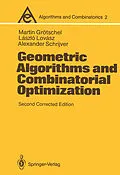Since the publication of the first edition of our book, geometric algorithms and combinatorial optimization have kept growing at the same fast pace as before. Nevertheless, we do not feel that the ongoing research has made this book outdated. Rather, it seems that many of the new results build on the models, algorithms, and theorems presented here. For instance, the celebrated Dyer-Frieze-Kannan algorithm for approximating the volume of a convex body is based on the oracle model of convex bodies and uses the ellipsoid method as a preprocessing technique. The polynomial time equivalence of optimization, separation, and membership has become a commonly employed tool in the study of the complexity of combinatorial optimization problems and in the newly developing field of computational convexity. Implementations of the basis reduction algorithm can be found in various computer algebra software systems. On the other hand, several of the open problems discussed in the first edition are still unsolved. For example, there are still no combinatorial polynomial time algorithms known for minimizing a submodular function or finding a maximum clique in a perfect graph. Moreover, despite the success of the interior point methods for the solution of explicitly given linear programs there is still no method known that solves implicitly given linear programs, such as those described in this book, and that is both practically and theoretically efficient. In particular, it is not known how to adapt interior point methods to such linear programs.
Inhalt
0. Mathematical Preliminaries.- 0.1 Linear Algebra and Linear Programming.- Basic Notation.- Hulls, Independence, Dimension.- Eigenvalues, Positive Definite Matrices.- Vector Norms, Balls.- Matrix Norms.- Some Inequalities.- Polyhedra, Inequality Systems.- Linear (Diophantine) Equations and Inequalities.- Linear Programming and Duality.- 0.2 Graph Theory.- Graphs.- Digraphs.- Walks, Paths, Circuits, Trees.- 1. Complexity, Oracles, and Numerical Computation.- 1.1 Complexity Theory: P and NP.- Problems.- Algorithms and Turing Machines.- Encoding.- Time and Space Complexity.- Decision Problems: The Classes P and NP.- 1.2 Oracles.- The Running Time of Oracle Algorithms.- Transformation and Reduction.- NP-Completeness and Related Notion.- 1.3 Approximation and Computation of Numbers.- Encoding Length of Numbers.- Polynomial and Strongly Polynomial Computations.- Polynomial Time Approximation of Real Numbers.- 1.4 Pivoting and Related Procedures.- Gaussian Elimination.- Gram-Schmidt Orthogonalization.- The Simplex Method.- Computation of the Hermite Normal Form.- 2. Algorithmic Aspects of Convex Sets: Formulation of the Problems.- 2.1 Basic Algorithmic Problems for Convex Sets.- 2.2 Nondeterministic Decision Problems for Convex Sets.- 3. The Ellipsoid Method.- 3.1 Geometric Background and an Informal Description.- Properties of Ellipsoids.- Description of the Basic Ellipsoid Method.- Proofs of Some Lemmas.- Implementation Problems and Polynomiality.- Some Examples.- 3.2 The Central-Cut Ellipsoid Method.- 3.3 The Shallow-Cut Ellipsoid Method.- 4. Algorithms for Convex Bodies.- 4.1 Summary of Results.- 4.2 Optimization from Separation.- 4.3 Optimization from Membership.- 4.4 Equivalence of the Basic Problems.- 4.5 Some Negative Results.- 4.6 Further Algorithmic Problems for Convex Bodies.- 4.7 Operations on Convex Bodies.- The Sum.- The Convex Hull of the Union.- The Intersection.- Polars, Blockers, Antiblockers.- 5. Diophantine Approximation and Basis Reduction.- 5.1 Continued Fractions.- 5.2 Simultaneous Diophantine Approximation: Formulation of the Problems.- 5.3 Basis Reduction in Lattices.- 5.4 More on Lattice Algorithms.- 6. Rational Polyhedra.- 6.1 Optimization over Polyhedra: A Preview.- 6.2 Complexity of Rational Polyhedra.- 6.3 Weak and Strong Problems.- 6.4 Equivalence of Strong Optimization and Separation.- 6.5 Further Problems for Polyhedra.- 6.6 Strongly Polynomial Algorithms.- 6.7 Integer Programming in Bounded Dimension.- 7. Combinatorial Optimization: Some Basic Examples.- 7.1 Flows and Cuts.- 7.2 Arborescences.- 7.3 Matching.- 7.4 Edge Coloring.- 7.5 Matroids.- 7.6 Subset Sums.- 7.7 Concluding Remarks.- 8. Combinatorial Optimization: A Tour d'Horizon.- 8.1 Blocking Hypergraphs and Polyhedra.- 8.2 Problems on Bipartite Graphs.- 8.3 Flows, Paths, Chains, and Cuts.- 8.4 Trees, Branchings, and Rooted and Directed Cuts.- Arborescences and Rooted Cuts.- Trees and Cuts in Undirected Graphs.- Dicuts and Dijoins.- 8.5 Matchings, Odd Cuts, and Generalizations.- Matching.- b-Matching.- T-Joins and T-Cuts.- Chinese Postmen and Traveling Salesmen.- 8.6 Multicommodity Flows.- 9. Stable Sets in Graphs.- 9.1 Odd Circuit Constraints and t-Perfect Graphs.- 9.2 Clique Constraints and Perfect Graphs.- Antiblockers of Hypergraphs.- 9.3 Orthonormal Representations.- 9.4 Coloring Perfect Graphs.- 9.5 More Algorithmic Results on Stable Sets.- 10. Submodular Functions.- 10.1 Submodular Functions and Polymatroids.- 10.2 Algorithms for Polymatroids and Submodular Functions.- Packing Bases of a Matroid.- 10.3 Submodular Functions on Lattice, Intersecting, and Crossing Families.- 10.4 Odd Submodular Function Minimization and Extensions.- References.- Notation Index.- Author Index.
